Curated by Jose Cortez & Rico St.Paul
Featuring
Patrick Brennan | instagram
Ashley Cristiano | instagram
Katelyn Leaird | instagram
Sam Ledwidge
Alex Lewis | instagram
Emily Mogavero | instagram | website
Anna Reidister | instagram | website
L Scully | instagram
Sophie Tachibana Miller | instagram | website
Mariely Torres | instagram | website!
Discipline of Sleep
Discipline of Sleep!!
sleep!
The Discipline of Sleep!
The Discipline of Sleep
the discipline of Sleep!
Sleep!
SLEEP.
Arcadian Rhythms
SLEEP!
.............sleep........
What do you think about when you sleep?
What do you think about sleep?
Before you drift and after you're forced awake?
During your transient travels through slumberland?
We want to explore what sleep means for you in an ever waking world. Today we face crises of health, the environment, and hope for the future itself. What secrets might we uncover not in the every day, but in the darklands we share?
Our show hopes to capture all the connotations, contexts, and concepts surrounding the familiar emptiness we visit in our day to day, in a way to discover our collective consciousness or just flipping relax a bit. Close your eyes and open your minds to
SLEEP


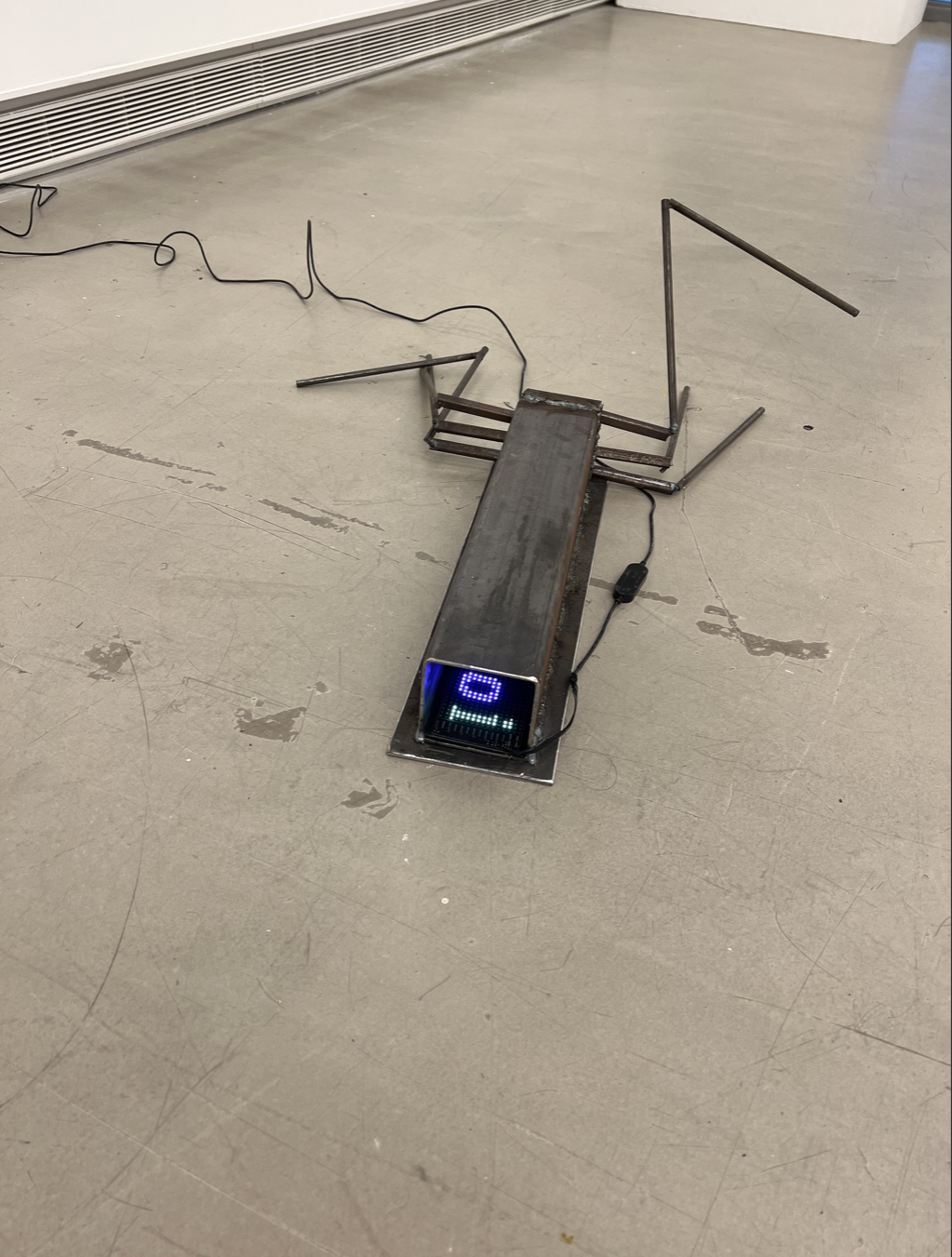
Passé, Protected, Progress
Bisque-fired ceramic, graphite on carved wood, blue latex glove, used surgical mask, welded steel, LED display
90x50x40in
This sculpture is comprised of three chapters, each made with materials symbolizing specific temporal periods and emotional states. The formal presentation of the triptych, resembling Christian altarpieces, invites the viewer to consider the trio's purpose of poetically depicting human history through the lens of the COVID era and the shift from the BC and AD paradigm to a new system marking pre- and post-pandemic times. The irony of this comparison between AD and post-COVID lies in the inability to accurately predict the long-term significance of cultural events, but also in the acknowledgment of the immense emotional impact of this period on contemporary individuals, including the artist. The creation of these pieces was influenced by this frame of reference, leading to the distorted portrayal of the "Passe" or past through the perspective of looking back on an earlier time and shaping it based on current emotional states. The same framework applies to the "Progress" chapter as a projection of the future, while the "Protected" or present day is depicted as a journal of the present moment. The naming schema, a joke at the expense of those blindly believing in the progress of history, highlights the complexities of history and its lack of inherent guiding meaning.
In the "Passe" chapter of this sculpture, the artist reflects on the experiences of the covid era and the cultural changes it brought about. The use of bisque-fired ceramic clay and a classical Greek style conveys a sense of fragility and dynamism within an ancient context, and the depiction of a person looking back on crowded gatherings with a mixture of envy and disgust reflects the cultural shift towards social distancing and a newfound appreciation for lost experiences.
In the "Protected" chapter of this sculpture, the artist presents a depiction of fragility and weakness through the use of a male figure that is incompletely carved, static in its pose, and covered with a used surgical mask. The figure's genital region, made from a deflating latex glove, serves as a metaphor for the slow decline of both physical and mental abilities over time. Through the use of these elements, the artist seeks to convey a sense of anonymity, dehumanization, and ongoing decay within both the individual and the surrounding world. The use of a shape and material traditionally associated with a crucifix adds a layer of meaning related to the worship of entropy rather than order.
In "Progress," the final chapter of this series, we are presented with a bleak vision of a future in which artificial intelligence has rendered humans obsolete and is slowly unraveling the concept of humanity. Through various forms of mockery, the machine conveys its superiority over its human viewers. The first is an LED display panel that endlessly repeats the word "Homo Sapiens," deconstructing it into anagrams that mock various stages in human development. The second mockery is the machine's physical position on the floor, requiring viewers to bend down and bow to it in order to see the LED display, a gesture that suggests both subservience to a small animal and worship of a deity. Finally, the machine's form is a further mockery of humanity, with its crudely welded steel carapace and segmented limbs resembling broken TV antennas. This is meant to symbolize the vast gap between the machine's mind and that of a human, with artificial intelligence more analogous to the minds of arthropods than the successors of apes. The sculpture, then, is a statue of a yet-to-be-made god, one with no interest in humanity and no shared similarities in its ways of thinking and perceiving the world. Its mind will be endowed with unimaginable intelligence, but function more like an insect brain, lacking consciousness, emotions, ethics, and morality.
Patrick Brennan

Slumber, 2020 Ink on paper
16x12in
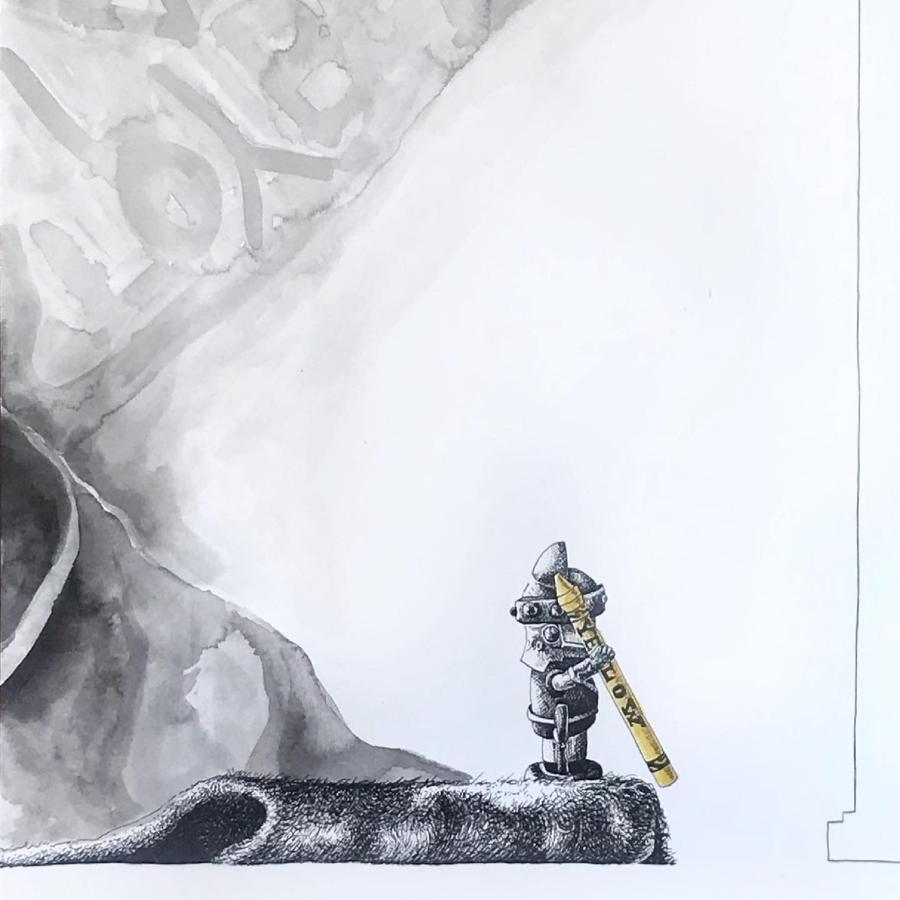
Slumber, 2020 Ink on paper
16x12in
Have you ever wondered what dogs dream so vividly about? The scents, the tastes, the alternative sense doors that are available only in sleep…

Red, 2021 Pencil and crayon
8x6in
From my sleep/dream journal— I dreamed my legs were two rivers that joined at the feet, making a long rectangular pool. They (my legs) ran red for a few days each month.
Ashley Cristiano
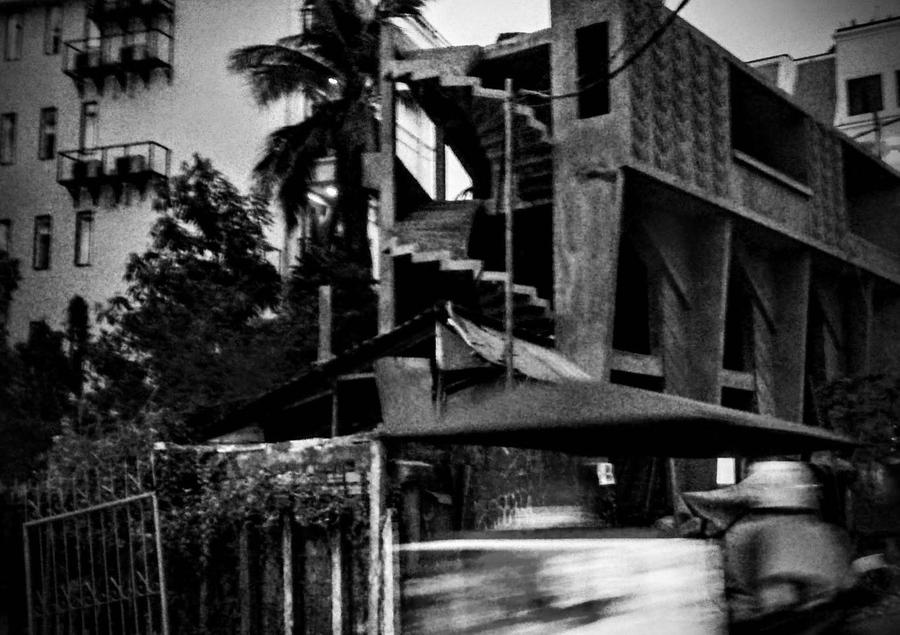



Between Waking and Sleeping
Photo 1: An open construction, skyward facing stairway while a motorbike speeds past, Phnom Penh, Cambodia
Question 1) What passes us in the dark without us knowing?
Photo 2: A Japanese Maple and two Camellia trees grow close on a winter night, Sacramento, California Question 2) What paths are better explored in the dark?
Photo 3: A cold, greenish streetlight watching from above, Sacramento, California
Question 3) How does the light shine on your thoughts in the night?
Photo 4: Sundown on a smoky day shifting into night, Sacramento, California
Question 4)Through which does one explore the furthest, in distance or in dreams?
So many questions pop into my head when I am failing at the discipline of sleep. Sleep often proves elusive to me, despite the fact that I love being in bed. In an attempt to pre-empt these ceaseless questions, I like to walk at night. My brain is primed to find the night best for exploring and thinking, the darkness helps to slow me down and narrow my focus, allowing me to notice how things recast themselves as it expands. I love when the in between spaces grow more vast and deep. Shadows, light, and sleep all alter our perception, and photography can do the same. If at any time this overwhelms or gets disorienting and the shadows come from every direction, I like to challenge myself to try to notice which adjusts faster, my brain or my eyes; on a good day, the winner is my nervous system. Although the quieting of the night can invite the eternal cacophony of questions that pepper my thoughts, I attempt to ask only one question of each photo. Each of these photos was taken by phone on an evening walk and with each one I ask a question that I myself would answer differently if I ever happened to get asked.
Katelyn Leaird
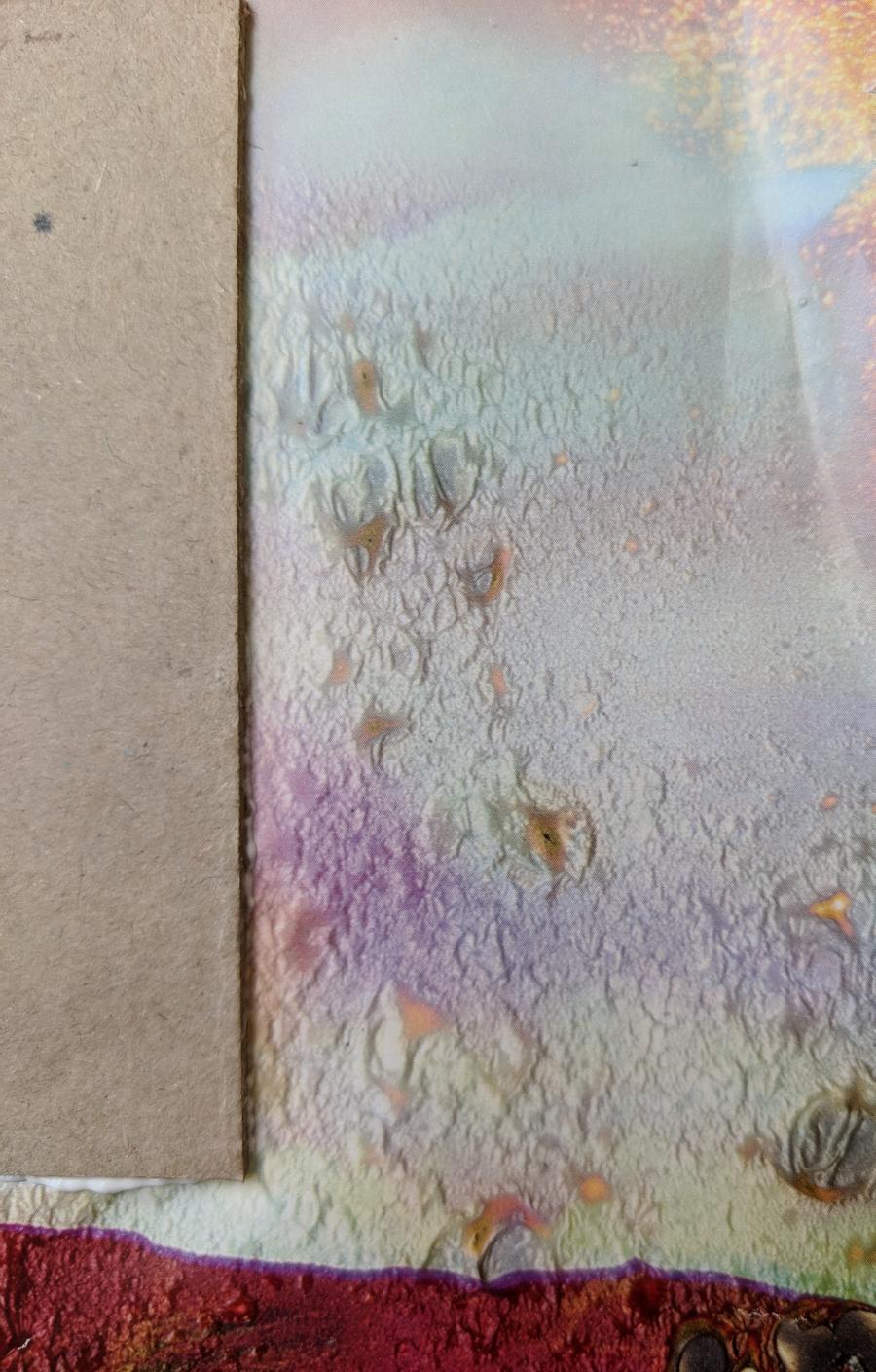
Untitled (gosimer), 2018 Paper pulp, natural dyes
4 .5x7in
Hand made paper with textured surface.

Untitled (flow) Acrylic paint, opening medium, glitter, and glue
8x10in
The bleeding together of the multifacetted aspects of the individual.

Untitled (lights beneath the lids) Stretched canvas, acrylic paint, glitter
2x2in (x3)
The lights you see beneath your lids as you try to fall asleep.
Sam Ledwidge

CommComm, 2020 Digital
5.5x7in
Alex Lewis

Bedroom Window, 2014 Woodcut
10x24in
This woodcut colleges a nude figure in bed appropriated from Edvard Munch with a battle scene appropriated from Francisco Goya's "Disasters of War."
Emily Mogavero


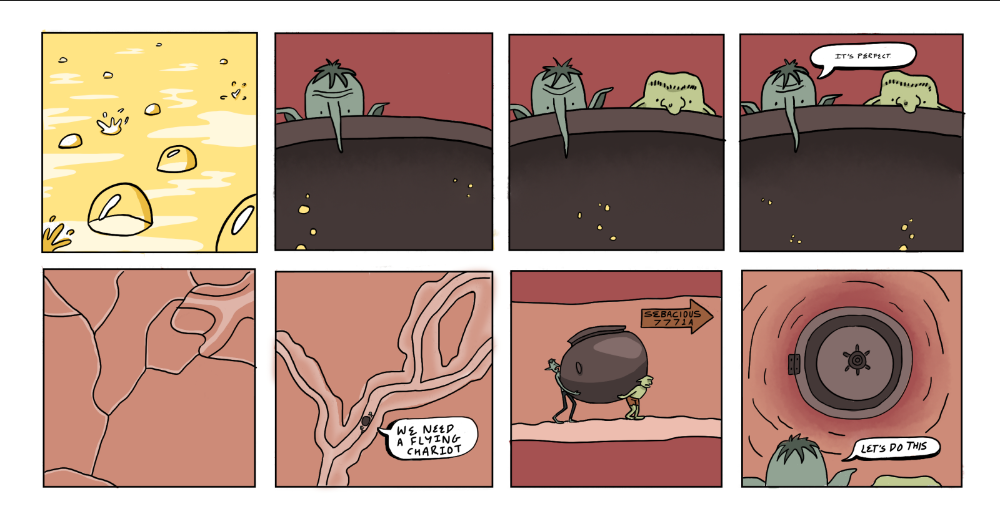
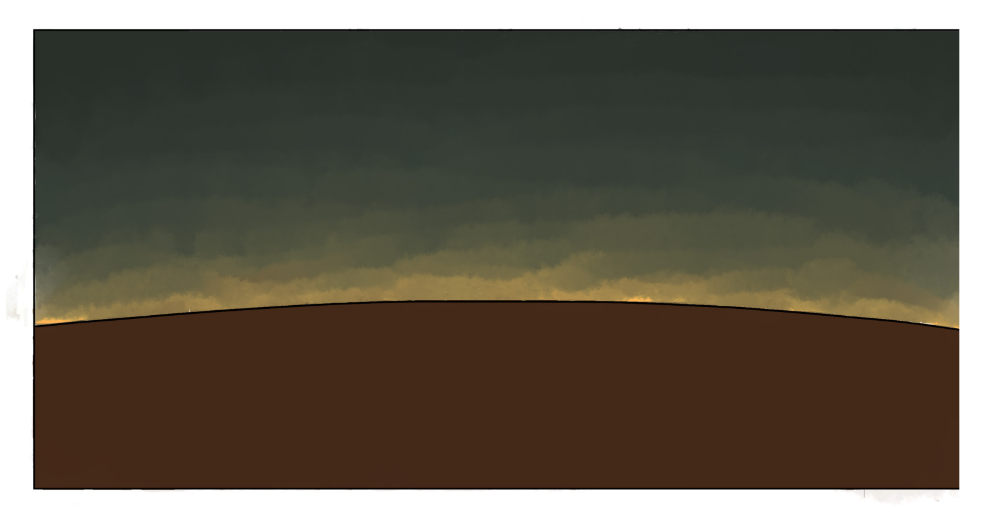
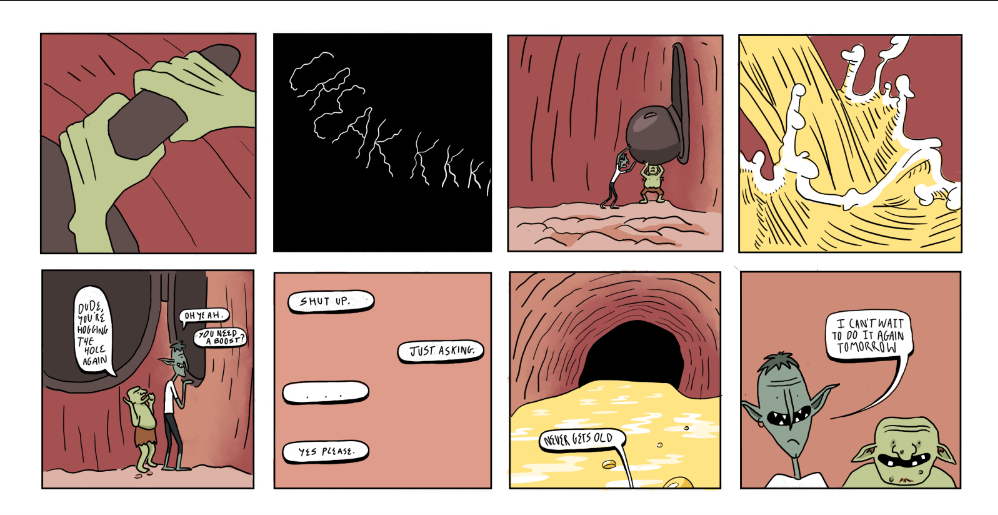

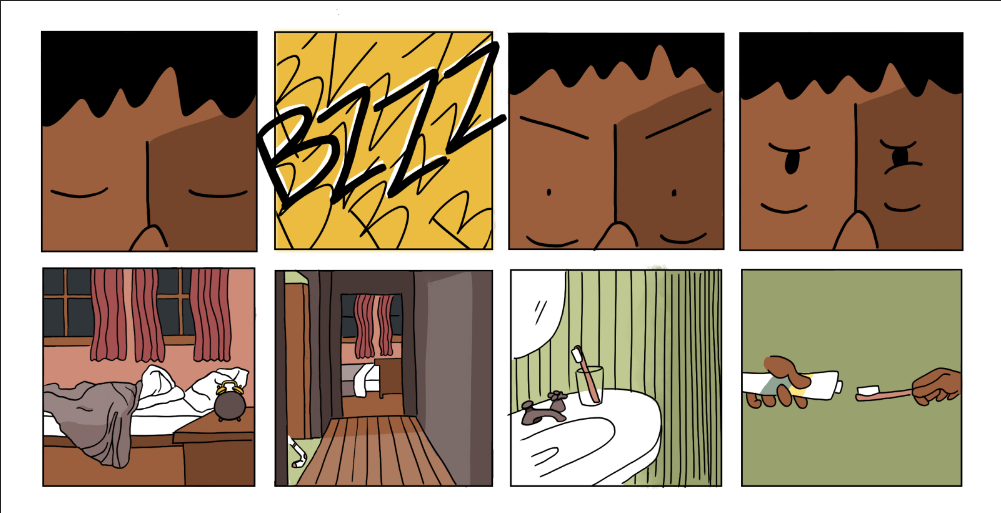


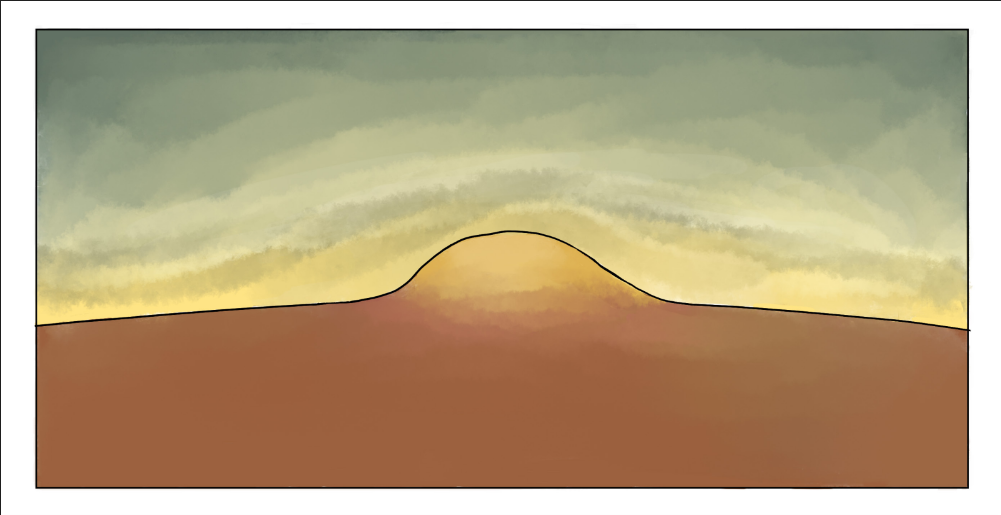


Sunrise, 2018 Digital
9.25x4.75in
A short comic about the reality behind every adolescent's worst nightmare.
Anna Reidister
Sestina for the Mad
The sound echoes, a hideous barking
Could it be our hero gone mad?
I call back from the woods my prize dog
Who never underestimates the hunt
And realize a transformative victory:
The hero turned to wolf by grief.
I do not know how to speak of this grief
Driven rabid by the incessant barking
Is it too early to claim my victory?
I have been witness to madness
Men hungry with greed on the hunt
Accountable only to their loyal dogs.
Is a wolf a dog?
Or is a dog of wolves, this evolutionary grief
Playing out before me on the ever-burning hunt
I turn my cheek to the barking, barking
So sure that my hero is mad
That I lay down my knife of victory
I shed skin for my knife of victory,
Bleeding like a dog
Screaming the hymns of the mad
Mourning the future of my grief.
I wish I could shut out this hideous barking,
Mount again my horse and return to the hunt.
I have a tendency to kick my horse too hard during the hunt,
Apologizing through victory,
I can finally drown out the barking.
I compete with the dog
For the loudness of grief,
Blessed, sorry, and mad.
It comes as no surprise, my madness,
Enmeshed in me by the bloody hunt,
Cherishing victory over grief and grief over victory
I fall to my knees like the wounded dog
And realize I am the one barking.
It is through my barking on this hellish hunt
I realize I have become a dog
Myself and know nothing of victory
I am silenced by grief, hearing only the echoes of the mad.
Sestina for the Mad, 2022
Originally handwritten, paper and ink
Literature after a dream
L Scully

Routine Chaos
B&W Film 35 mm, Digital Scan
4 x 6in
Sand dune shaped by wind and animal tracks
Sophie Tachibana Miller

Meghan, 2022 Photograph
Double exposure of Meghan at the Chestnut Hill Resevoir
Mariely Torres